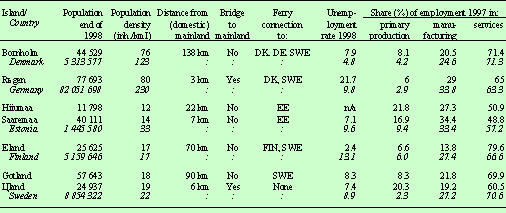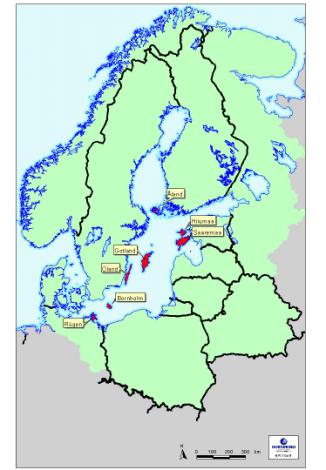3.6 Islands
Challenges regarding
BSR islands
- Develop the islands' economies while maintaining and activating their cultural identity;
- Reduce accessibility disadvantages through enhanced use of telecommunication and improved travel links (ferries, air services);
- Develop new economic sectors less dependent on travel cost (tourism, other services);
|
The BSR is a region with a high number of islands. The largest archipelagos are in Finland and Sweden. The total number of islands (>100 m2) on the coast of Finland is around 81,000 and in the inland lakes there are a further 98,000 islands. The Aland islands are a unique case of a community with self-governance, exceptional tax laws, and limited rights of 'mainlanders'.
|
Main indicators of the Baltic Sea Seven Islands
|

|
| Source: National Statistical Institutes and B7 website
|
In Sweden some 30,000 people live in the archipelago area on some 300 is-lands. The majority of permanent resi-dents are on the Swedish west coast (20,000) and in the archipelago of Stockholm (7,000).
In Denmark there are, in addition to Sjælland, Jylland and Fyn, some 525 islands of which 81 are inhabited. Of these, Lolland, Bornholm and Falster are the largest.
|
The Baltic Sea Seven Islands
|

|
In Estonia 52,000 persons or 3.6% of the country's population live on the two largest islands Saaremaa and Hiiumaa. Rügen is Germany's largest island with a population of nearly 78,000.
In addition to these main island areas in the Baltic Sea, virtually the entire coast of Norway is dotted with numerous islands. Many of these are permanently inhabited, the largest ones being in the Lofoten and Vesterålen island archipelagos in the north of the country.
Latvia, Lithuania and Poland as well as the Russian BSR regions lack substantial island population, though e.g. the population on the Kuronian Spit, Hel and Usdeom peninsulas could be characterised as living under similar conditions as inhabitants on other major BSR islands.
Most islands can be characterised as peripheral, with long distances to markets and other neighbouring regions, small local markets, large dependency on the public sector for employment and a relatively low level of education (albeit there are some notable exceptions). They are also characterised by strong identity and preservation of cultural heritage.
Of the "Baltic Sea Seven Islands" or B7 two (Rügen and Öland) have fixed links to the mainland. The remaining (Bornholm, Gotland, Saaremaa, Hiiumaa and Aland) rely on road ferries and air links. Flight services are gaining increasing importance.
There are islands with above national average unemployment, as well with a below-average one. On Rügen (21.7% in 1998) it is more than double the German average and around 1/2 times higher on Bornholm and Saaremaa. On all other B7 islands unemployment rates are similar to or below national averages. Åland is an extreme case with near full employment.
Primary production (fishing, agriculture, farming, forestry), the traditional livelihood on the islands, is gradually being replaced by the service sector. Still, on many islands primary industries constitute a substantial share of all employment.
UNESCO world heritage sites, Hanseatic cities with connecting routes in the BSR
Source: Nordregio
Although an increasing public service sector in many cases has absorbed the downturn in primary sector employ-ment, the structural change in the island's economies is most obvious when looking at the development of the tourism sector.
Tourism plays an increasingly important role in the economies of all seven islands. Of the B7 islands, Öland and Åland are the largest destinations in the BSR, with some 2.0 and 1.6 million annual visitors respectively.
The number of visitors is even larger if visitors with permanent summer or recreational houses would be counted.
Tourism on islands is highly dependent on cyclical variations in the economy, fashion, weather and other factors out of control of the islands themselves.
A majority of visitors to the islands are domestic. Foreign visitors usually stem from other BSR countries.

